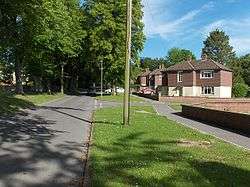Bulford Camp
| Bulford Camp | |
|---|---|
| Bulford | |
|
Gaza Road, Bulford Camp | |
 Bulford Camp Location within Wiltshire | |
| Coordinates | 51°11′28″N 1°44′03″W / 51.19111°N 1.73417°WCoordinates: 51°11′28″N 1°44′03″W / 51.19111°N 1.73417°W |
| Type | Military Base |
| Site information | |
| Owner | Ministry of Defence |
| Operator |
|
| Site history | |
| Built | 1897 |
| Built for | War Office |
| In use | 1897-Present |
| Garrison information | |
| Occupants |
3rd (UK) Division 12th Armoured Infantry Brigade 1st Battalion The Mercian Regiment 5th Battalion The Rifles |
Bulford Camp is a military camp on the Salisbury Plain in Wiltshire, England. Established in 1897, the site continues in use as a large British Army base. The camp is close to the village of Bulford and is about 2 1⁄4 miles (3.6 km) northeast of the town of Amesbury.
History
The camp was built as a mixture of tents and huts in 1897.[1] The section called Sling Camp was occupied by New Zealand soldiers of the Australia New Zealand Army Corps (ANZAC) during the First World War. The ANZACs left their mark by creating the Bulford Kiwi, a large mural on the hillside.[2] At the end of the war, the camp was the site of the Battle of Bulford, when ANZAC troops staged a brief mutiny.[3][4]
Permanent barracks were built during the inter-war years: the current names were applied in 1931.[5] Carter Barracks, a hutted camp north of Bulford Droveway, beyond the northern boundary of the present site, were built in 1939-40 and demolished in 1978.[6]
Today
The modern-day Bulford Camp is on two sites, separated by Marlborough Road. The camp on the eastern side contains Picton Barracks which since 1992 has housed the headquarters of 3rd (UK) Division and its Signals Regiment.[7] Kiwi Barracks, where many of the streets are named after New Zealand towns, houses 3rd Regiment Royal Military Police.[8] 5th Battalion The Rifles will move to Bulford Camp from Germany in 2016.[9]
The camp on the western side contains Ward Barracks which houses the headquarters of 12th Armoured Infantry Brigade.[10] The Headquarters of the Special Investigation Branch of the Royal Military Police is housed at Campion Lines which is also on the western side.[11]
Churches

The garrison church of St George was built in 1920-7.[12] Pevsner describes it as "large, Perpendicular, spick and span and smug".[13]
The Catholic church of Our Lady Queen of Peace was built in 1968, replacing a church of Our Lady of Victories which was opened in 1925.[6]
Schools
Kiwi Primary School, under County Council control since 1948, serves the camp from a building which was opened in 1965.[14]
The first school at the camp was opened in Wing Barracks before 1915, then transferred to the County Council in 1948 and renamed Wing County Junior School in 1955. In 1963 this school was combined with Kiwi Infants' County School to form the present Kiwi School.[15] Until 1997 there was a second primary school, Haig County Primary School.[16][17]
Former railway
In 1906 the Amesbury and Military Camp Light Railway was extended from Amesbury into the camp. The station within the camp was the terminus for personnel while a goods track extended into Sling Camp. This extension was removed in 1933; the whole line closed to passengers in 1952 but goods services continued until 1963.[18]
References
- ↑ "Bulford Camp Then and Now". Retrieved 5 April 2014.
- ↑ "Facelift for the Bulford Kiwi" (PDF). Drumbeat. July 2007. Retrieved 23 November 2014.
- ↑ "Merely For the Record": The Memoirs of Donald Christopher Smith 1894-1980. By Donald Christopher Smith. Edited by John William Cox, Jr. Bermuda. (A Bermudian officer (1914 Rhodes Scholar for Bermuda, later a prominent lawyer, and a Member of the Colonial Parliament (MCP) of Bermuda for twenty years) serving in the Royal Field Artillery, Lieutenant Smith's unit, among others, was sent with small arms to surround Bulford Camp for two days, after which the mutiny fizzled out).
- ↑ The Rhodes Trust. Register Of Bermuda Rhodes Scholars: 1914 - Smith, Donald Christopher (his brother, Sir Allan Chalmers Smith, was the 1912 Rhodes Scholar. 1913 Rhodes Scholar, Major Charles G.G. Gilbert, MC, was their cousin, and his son was Major-General Glyn Gilbert)
- ↑ "Bulford". Wiltshire Community History. Retrieved 23 November 2014.
- 1 2 Crowley, D.A. (ed.). "Victoria County History - Wiltshire - Vol 15 pp61-70 - Parishes: Bulford". British History Online. University of London. Retrieved 9 March 2016.
- ↑ "3 Regiment". British Army units 1945 on. Retrieved 23 November 2014.
- ↑ "The location in the UK of each army regiment". Ministry of Defence. Retrieved 1 December 2015.
- ↑ "5 Rifles". Ministry of Defence. Retrieved 24 May 2016.
- ↑ "12th Armoured Infantry Brigade". Ministry of Defence. Retrieved 23 November 2014.
- ↑ "Royal Military Police Special Investigation Branch" (PDF). Ministry of Defence. Retrieved 23 November 2014.
- ↑ "Church of St. George, Bulford". Wiltshire Community History. Wiltshire Council. Retrieved 9 March 2016.
- ↑ Pevsner, Nikolaus; Cherry, Bridget (revision) (1975) [1963]. Wiltshire. The Buildings of England (2nd ed.). Harmondsworth: Penguin Books. p. 152. ISBN 0-14-0710-26-4.
- ↑ "Kiwi School, Bulford". Wiltshire Community History. Wiltshire Council. Retrieved 9 March 2016.
- ↑ "Wing County Junior School, Bulford". Wiltshire Community History. Wiltshire Council. Retrieved 9 March 2016.
- ↑ "Haig County Primary School, Bulford". Wiltshire Community History. Wiltshire Council. Retrieved 9 March 2016.
- ↑ "Haig County Primary School". EduBase. Department for Education. Retrieved 9 March 2016.
- ↑ Oakley, Mike (2004). Wiltshire Railway Stations. Wimborne: The Dovecote Press. p. 27. ISBN 1904349331.
